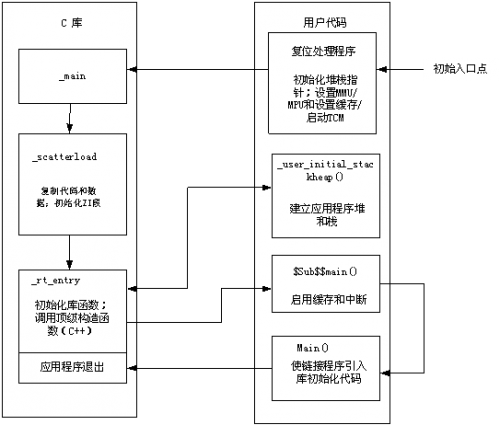PCI設(shè)備初始化編程的過(guò)程
這里以PowerPC上的PCI設(shè)備為例,介紹PCI設(shè)備初始化編程的過(guò)程,其他CPU的PCI基本框架是類(lèi)似的.
PowerPC的PCI控制器符合PCI2.2標(biāo)準(zhǔn),以下使我解讀的VxWorks系統(tǒng)PCI設(shè)備程序代碼分析
主要執(zhí)行過(guò)程
1.初始化PCI設(shè)備
文件romInit.s中romInit()=======>文件bootInit.c中romStart()========>文件usrConfig.c中的usrInit()======>文件syslib.c中的sysHwInit()
syslib.c
void sysHwInit (void){ //用于初始化系統(tǒng)硬件
......................
//和網(wǎng)絡(luò),PCI有關(guān)的函數(shù)
#ifdef INCLUDE_EMAC_NETWORK
//初始化媒介訪問(wèn)層MAL(控制EMAC和Buffer Descriptor BD間的數(shù)據(jù)傳輸)
malReset();
#endif
#ifdef INCLUDE_PCI
pciInit(); //初始化PCI
#endif
#ifdef INCLUDE_NETWORK
sysNetHwInit(); //初始化網(wǎng)絡(luò)接口
#endif
}
//該函數(shù)初始化PCI
PCI的地址轉(zhuǎn)換形式:
CPU->PCI (master/initiator) 地址轉(zhuǎn)換
PCI->CPU (slave/target) 地址轉(zhuǎn)換
void pciInit()
{
unsigned short temp_short;
/*
* 初始化并 disable 所有的 PCI Master regions(三個(gè)),
little endian,直接對(duì)寄存器R操作 */
sysPciOutLong(PMM0MA, PMM_UNUSED);
sysPciOutLong(PMM1MA, PMM_UNUSED);
sysPciOutLong(PMM2MA, PMM_UNUSED);
/*
解釋:
PMM0MA:地址 0xEE400004, 控制PLB上的映射到PCI存儲(chǔ)空間的range0大小和屬性.
在PLB上共有三個(gè)ranges, PMM1MA代表區(qū)域rang1, PMM2MA代表區(qū)域range2.
PMM_UNUSED: 0x00000000
range的定義
range: map PLB======>PCI 64-bit
PPBridge(PLB和PCI設(shè)備間的接口)responds as a target on the PLB bus in servral address ranges.
These ranges allow a PLB Master to configure the PPBridge and to cause PPBridge to generate Mem I/O,interrupt acknowledge and special cycles to PCI bus.
*/
/*
* Initially disable PCI Target region 2 to start. Region 1 is hardwired
* to always be active.
*/
//PTM2MS:地址 0xEF400038,定義PCI存儲(chǔ)空間的大小.這里清零
sysPciOutLong(PTM2MS, PTM_UNUSED);
/*
* Drive PCI 重新置位. 用于熱啟動(dòng),置位必須保持1ms
*/
//解釋: 從PCI寄存器PCI_CFG_BRIDGE_OPT2中讀出數(shù)值
其中 PPC405GP_PCI_BUSDEVFUNC = 0x00000000;
PCI_CFG_BRIDGE_OPT2 = 0x60
temp_short = pciConfigIn(PPC405GP_PCI_BUSDEVFUNC, PCI_CFG_BRIDGE_OPT2, 2);
//把讀出的值放回寄存器PCI_CFG_BRIDGE_OPT2中
pciConfigOut(PPC405GP_PCI_BUSDEVFUNC, PCI_CFG_BRIDGE_OPT2,
temp_short | 0x1000, 2);
sysLocalDelay(1); /* 延時(shí)1ms kernel may not be up yet!! */
//再放一次
pciConfigOut(PPC405GP_PCI_BUSDEVFUNC, PCI_CFG_BRIDGE_OPT2, temp_short, 2);
/*
* 設(shè)置PCI Master(PMM),這是從本地存儲(chǔ)地址Local memory address到PCI空間的映射 * CPU->PCI,參見(jiàn)文件 See config.h中的定義,參考 BSP配置文件
*/{{分頁(yè)}}
//說(shuō)明sysPciOutLong(A,B);放B到A
//PMM region 0
//PMM0LA 0xEF400000, PMM0_LOCAL_ADRS 0x80000000
sysPciOutLong(PMM0LA, PMM0_LOCAL_ADRS);
//PMM0PCILA 0xEF400008, PMM0_PCI_LOW_ADRS 0x80000000
sysPciOutLong(PMM0PCILA, PMM0_PCI_LOW_ADRS);
//PMM0PCIHA 0xEF40000C, PMM0_PCI_HIGH_ADRS 0x00000000
sysPciOutLong(PMM0PCIHA, PMM0_PCI_HIGH_ADRS);
//PMM0MA 0xEF400004,
//PMM0_PCI_MASK_ATTRIB PMM_MASK_512MB|PMM_ENABLE
sysPciOutLong(PMM0MA, PMM0_PCI_MASK_ATTRIB);
sysPciOutLong(PMM1LA, PMM1_LOCAL_ADRS); /* PMM region 1 */
sysPciOutLong(PMM1PCILA, PMM1_PCI_LOW_ADRS);
sysPciOutLong(PMM1PCIHA, PMM1_PCI_HIGH_ADRS);
sysPciOutLong(PMM1MA, PMM1_PCI_MASK_ATTRIB);
sysPciOutLong(PMM2LA, PMM2_LOCAL_ADRS); /* PMM region 2 */
sysPciOutLong(PMM2PCILA, PMM2_PCI_LOW_ADRS);
sysPciOutLong(PMM2PCIHA, PMM2_PCI_HIGH_ADRS);
sysPciOutLong(PMM2MA, PMM2_PCI_MASK_ATTRIB);
/*
* 設(shè)置 PCI Target (PTM). 這是從PCI的地址到本地地址的映射
* 參見(jiàn)文件 config.h中的定義
* 如果不是用 region 2, 必須保證它的使能位關(guān)閉,region 1硬件連接使能.
*/
//PTM1LA 0xEF400034, PTM1_LOCAL_ADRS 0x00000000
sysPciOutLong(PTM1LA, PTM1_LOCAL_ADRS);
//PTM1MS 0xEF400030,
sysPciOutLong(PTM1MS, PTM1_SIZE_ATTRIB);
...................
/*
* 寫(xiě) 405GP PCI 設(shè)置寄存器.
* 使能 405GP,使其成為PCI總線的一個(gè)master (PMM).
* 使能 405GP 作為一個(gè)PCI memory target (PTM).
*/
temp_short = pciConfigIn(PPC405GP_PCI_BUSDEVFUNC, PCI_CFG_COMMAND, 2);
temp_short = temp_short | PCI_CMD_MASTER_ENABLE | PCI_CMD_MEM_ENABLE;
pciConfigOut(PPC405GP_PCI_BUSDEVFUNC, PCI_CFG_COMMAND, temp_short, 2);
..........................
/*
* 作為PCI的主機(jī)host掃描PCI總線,查找PCI設(shè)備. 并為每個(gè)設(shè)備分配唯一的PCI或I/O地址* 空間
*/
pciScan(0);
return;
}
//pciScan() - 掃描PCI總線,根據(jù)PCI ID和 vender ID查找設(shè)置現(xiàn)有的PCI設(shè)備
void pciScan
(
int busNum
)
{
int Device;
int BusDevFunc;
/*
* 從device 1開(kāi)始,查找每個(gè)Slot,如有PCI設(shè)備,分配內(nèi)存和I/O, 405GP是 device 0.
*/
for (Device = 1; Device <= WALNUT_NUM_PCI_SLOTS; Device++)
{
BusDevFunc = (busNum << 16) | (Device << 11);
//如果Device存在
if (pciConfigIn(BusDevFunc, PCI_CFG_VENDOR_ID,2) != 0xFFFF)
{
#ifdef PCIDEBUG
printf("* * * * * * * * * * * * * * * * *n");
printf("Device %d is presentn",Device);
#endif
switch( pciConfigIn(BusDevFunc, PCI_CFG_SUBCLASS, 2) )
{
case 0x0604: /* PCI-PCI Bridge */
break;
default:
pciDumpDevice(BusDevFunc); //打印 Vendor ID, Device ID
//調(diào)用pciConfigDevice(BusDevFunc, 6)對(duì)PCI設(shè)備進(jìn)行設(shè)置
pciConfigDevice(BusDevFunc, 6);
}
}
else
{
#ifdef PCIDEBUG
printf("Device %d not presentn",Device);
#endif
}
}
}
//pciConfigDevice - 為PCI設(shè)備配置內(nèi)存和I/O方式
void pciConfigDevice(int BusDevFunc,int NumBaseAddr)
{
int AddrSlot;
int i;
unsigned long AddrDesc;
unsigned long AddrProg;
unsigned long Min_Gnt_Val;
// NumBaseAddr = 6
for (AddrSlot = 0; AddrSlot < NumBaseAddr; AddrSlot++)
{
// PCI_CFG_BASE_ADDRESS_0 = 0x10 將0xFFFFFFFF寫(xiě)入 PCI_CFG_BASE_ADDRESS_0 + (4*AddrSlot)
pciConfigOut(BusDevFunc, PCI_CFG_BASE_ADDRESS_0 + (4*AddrSlot),
0xFFFFFFFF, 4);
// 從PCI_CFG_BASE_ADDRESS_0 + (4*AddrSlot)讀出數(shù)據(jù)
AddrDesc = pciConfigIn(BusDevFunc,
PCI_CFG_BASE_ADDRESS_0 + (4*AddrSlot),
4);
// 如果數(shù)據(jù)是0,沒(méi)有PCI設(shè)備,繼續(xù)循環(huán)搜索
if (AddrDesc == 0) /* unimplemented, stop looking */
continue;
#ifdef PCIDEBUG
printf("Read Base Addr Reg %d = 0x%08xn",AddrSlot,AddrDesc);
#endif
/* 如果AddrDesc的位0是0,表示是Mem方式 */
if ((AddrDesc & 1) == 0)
{
AddrDesc &= 0xFFFFFFF0;
for (i = 0; (AddrDesc & 1) != 1; i++) //查詢(xún)Mem的大小
AddrDesc = AddrDesc >> 1;
AddrDesc = 1 << i;
if ((unsigned long)AddrDesc < 4096)
AddrDesc = 4096;
#ifdef PCIDEBUG
printf(" PCI Memory space = 0x%x bytes n",AddrDesc);
#endif
for (AddrProg = PCI_MEMORY_START;
AddrProg < LowestMemAddr;
AddrProg += AddrDesc);{{分頁(yè)}}
pciConfigOut(BusDevFunc, PCI_CFG_BASE_ADDRESS_0 + (4*AddrSlot),
AddrProg, 4);
LowestMemAddr = AddrProg + AddrDesc;
}
else /* I/O 方式*/
{
AddrDesc &= 0xFFFFFFFC;
for (i = 0; (AddrDesc & 1) != 1; i++) //查詢(xún)I/O空間的大小
AddrDesc = AddrDesc >> 1;
AddrDesc = 1 << i;
#ifdef PCIDEBUG
printf(" PCI I/O space = 0x%x bytes n",AddrDesc);
#endif
for (AddrProg = PCI_IO_REGION_1_START;
AddrProg < LowestIOAddr;
AddrProg += AddrDesc);
pciConfigOut(BusDevFunc, PCI_CFG_BASE_ADDRESS_0 + (4*AddrSlot),
AddrProg, 4);
LowestIOAddr = AddrProg + AddrDesc;
}
}
/*
* Read Min_Gnt(0x3eh) register value and write it to
* the Latency Timer(0xdh) register
*/
Min_Gnt_Val = 0x80;
pciConfigOut(BusDevFunc, PCI_CFG_LATENCY_TIMER, Min_Gnt_Val, 1);
}
2.PCI網(wǎng)卡驅(qū)動(dòng)調(diào)用過(guò)程
sysNet.c用于初始化系統(tǒng)的網(wǎng)絡(luò)
文件sysNet.c中void sysNetHwInit(void)定義了,這里以AMD PCI網(wǎng)卡97x為例:
#ifdef INCLUDE_PCI_NETWORK
unsigned char sysEnetAddr [6]; /* 網(wǎng)卡的 MAC 地址 */
char sys97xLoadString[100]; /* 需要為初始化加載的字符串 */
#endif
#ifdef INCLUDE_PCI_NETWORK
STATUS sysIn97xEndBldLoadStr() // 生成網(wǎng)絡(luò)初始化的字符串
函數(shù)sysIn97xEndBldLoadStr()調(diào)用pciFindDevice()
STATUS pciFindDevice //用Vendor ID和Device ID查找PCI網(wǎng)卡
(
int VendorID,
int DeviceID,
int index,
int *busDevFunc
)
{
int Device;
int tmpBusDevFunc;
int tmpIndex;
int busNum;
tmpIndex = 0;
for (busNum = MaxBusNum; busNum >= 0; busNum--) //查訊Slot
{
for (Device = 0; Device <= WALNUT_NUM_PCI_SLOTS; Device++)
{
tmpBusDevFunc = (busNum << 16) | (Device << 11);
// 如果指定寄存器中Vendor ID和Device ID正確,賦值給*busDevFunc,返回
if (pciConfigIn(tmpBusDevFunc, PCI_CFG_VENDOR_ID, 2) == VendorID
&& pciConfigIn(tmpBusDevFunc, PCI_CFG_DEVICE_ID, 2) == DeviceID)
{
if (tmpIndex == index)
{
*busDevFunc = tmpBusDevFunc;
return (OK);
}
else /* have a match, but not correct index */
{
tmpIndex++;
}
} } }
return (ERROR); }
sysln97xEndBldLoadStr(..)查找PCI以太網(wǎng)卡,得到PCI網(wǎng)卡的基地址,根據(jù)PCI插槽Slot選擇正確的中斷向量,讀網(wǎng)卡的MAC地址,然后調(diào)用ln97xEndLoad
STATUS sysln97xEndBldLoadStr ( void )
{
int i;
int intvec;
int intlvl;
ULONG pciMemAddr;
unsigned int busDevFunc;
/*
* 在PCI總線上查找設(shè)置第一個(gè)AMD設(shè)備.
* 如果發(fā)現(xiàn)存在,函數(shù)pciFindDevice 為busDevFunc賦值
*/
if (pciFindDevice(PCI_VENDOR_ID_AMD, PCI_DEVICE_ID_79C97X, 0, &busDevFunc))
return(ERROR);
/*
* 97x的基地址 1 包含PCI存儲(chǔ)空間的基地址.
*/
pciMemAddr = pciConfigIn(busDevFunc, PCI_CFG_BASE_ADDRESS_1, 4);
pciMemAddr &= 0xFFFFFFF0;
/*
* 設(shè)置PCI定時(shí)器反應(yīng)時(shí)間為50 Set latency timer to 50.
*/
pciConfigOut(busDevFunc, PCI_LATENCY_TIMER, 50, 1);
/*
* 每個(gè)PCI插槽連接到中斷控制器的管腳不一樣,中斷取決于網(wǎng)卡插在哪一個(gè)PCI插槽上.
*/
switch ((busDevFunc & 0x0000F800) >> 11) /* Strip off just the device */
{
case 1 : intvec = INT_VEC_PCI_SLOT3; /* 插槽 3 */
intlvl = INT_LVL_PCI_SLOT3;
break;
case 2 : intvec = INT_VEC_PCI_SLOT2; /* 插槽 2 */
intlvl = INT_LVL_PCI_SLOT2;
break;
case 3 : intvec = INT_VEC_PCI_SLOT1; /* 插槽 1 */
intlvl = INT_LVL_PCI_SLOT1;
break;
case 4 : intvec = INT_VEC_PCI_SLOT0; /* 插槽 0 */
intlvl = INT_LVL_PCI_SLOT0;
break;
default : return(ERROR); /* Not possible, error */
}
/*
* 使能PCI Mem cycles 和 總線 Master 操作
*/
pciConfigOut(busDevFunc, PCI_CFG_COMMAND,
PCI_CMD_MEM_ENABLE | PCI_CMD_MASTER_ENABLE, 2);
/*
* 得到網(wǎng)卡的MAC地址
*/
for (i=0; i<6; i++)
sysEnetAddr = sysInByte(pciMemAddr+APROM01+i);
/*
* 生成初始化字符串,如一下形式:
*
* <devMemAddr>:<devIoAddr>:<pciMemBase>:<vecNum>:<intLvl>:<memAdrs>:
* <memSize>:<memWidth>:<csr3b>:<offset>:<flags>
*
* 這個(gè)字符串將在函數(shù)muxEndLoad()中加載
*/
sprintf(sys97xLoadString, "0x%x:0x%x:0:%d:%d:0x%x:0:0x%x:0:0:0",
(unsigned int)pciMemAddr, NONE, intvec, intlvl,
NONE,NONE);
return(OK);
}




評(píng)論